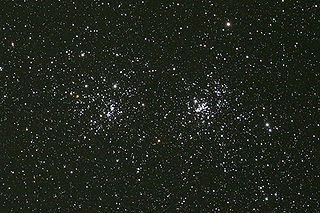- NGC 869
-
NGC 869 
The Double Cluster, NGC 869 (right) and NGC 884 (left) with north to the topObservation data (J2000 epoch) Constellation Perseus Right ascension 02h 19.1m[1] Declination +57° 09′[1] Distance 7.6 kly[2] (2.3 kpc[2]) Apparent magnitude (V) 5.3[1] Apparent dimensions (V) 30′[citation needed] Physical characteristics Mass - M☉ Radius - Estimated age 13 My [2] Notable features - Other designations Collinder 24,[1] Melotte 13,[1]
h Per,[1] h Persei[1]See also: Open cluster, List of open clusters NGC 869 is an open cluster located 7600 light years[2] away in the constellation of Perseus. The cluster is most likely around 13[2] million years old. It is the westernmost of the Double Cluster with NGC 884. Located in the Perseus OB1 association both clusters are located physically close to one another, only a few hundred light years apart. The clusters were first recorded by Hipparchus, but have likely been known since antiquity.
The Double Cluster is a favorite of amateur astronomers. These bright clusters are often photographed or observed with small telescopes. Easy to find, the clusters are visible with the unaided eye between the constellations of Perseus and Cassiopeia as a brighter patch in the winter Milky Way.
In small telescopes the cluster appears as a beautiful assemblage of bright stars located in a rich star field. Dominated by bright blue stars the cluster also hosts a few orange stars that add to the visual interest.
Sometimes known as h Per this designation more probably refers to a nearby dim star.[3]
References
- ^ a b c d e f g "SIMBAD Astronomical Database". Results for NGC 869. http://simbad.u-strasbg.fr/Simbad. Retrieved 2006-12-22.
- ^ a b c d e Slesnick et al.; Hillenbrand, Lynne A.; Massey, Philip (2002). "The Star Formation History and Mass Function of the Double Cluster h and Chi Persei". Astrophysical Journal 576 (2): 880–893. arXiv:astro-ph/0205130. Bibcode 2002ApJ...576..880S. doi:10.1086/341865. http://iopscience.iop.org/0004-637X/576/2/880/.
- ^ Stephen James O'Meara and Daniel W.E. Green, 2003, "The Mystery of the Double Cluster", Sky and Telescope,Vol. 105, No. 2, p. 116-119 (February 2003)
External links
Categories:- Open clusters
- Perseus constellation
- NGC objects
- Bayer objects
Wikimedia Foundation. 2010.
